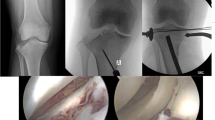Abstract
Introduction
Operative management of posterior tibial plateau fractures (PTPF) remains challenging. The treatment goal is to restore the alignment and articular congruence, and providing sufficient stability which allows early mobilization. The purpose of this study was to assess the feasibility and safety of the newly developed WAVE posterior proximal tibia plate.
Methods
Between Oct 2017 and Jun 2020, 30 adult patients with a tibial plateau fracture and posterior involvement were selected for treatment with a WAVE posterior proximal tibia plate. Patient reported outcome was assessed using the Knee injury and Osteoarthritis Outcome Score (KOOS) at time of injury (pre-injury) and at 1-year follow-up. Radiological outcome was evaluated with CT-imaging.
Results
Twenty-eight patients were eligible for treatment with the new implant (3 ‘one-column’, 10 ‘two column’ and 15 ‘three-column’ fractures), whereas in 2 patients anatomical fit was insufficient. KOOS results showed fair outcome scores at 1 year, with a large negative impact compared to pre-injury levels; however, a trend towards better results compared to a previous PTPF reference cohort. Radiological follow-up showed insufficient posterolateral buttress in two cases and residual articular step-off (> 2 mm) in seven patients, of which five were classified as three column fractures.
Conclusion
Management of PTPF using the WAVE posterior proximal tibia plate is feasible and safe with satisfactory clinical and radiological results after 1 year. Nevertheless, there is a learning curve regarding optimal implant positioning to achieve the maximum benefit of the implant.
Level of evidence
4.








Similar content being viewed by others
References
Van den Berg JD, Quintens L, Zhan Y, Hoekstra H. Why address posterior tibial plateau fractures? Injury. 2020. https://doi.org/10.1016/j.injury.2020.09.011.
Jiwanlal A, Jeray KJ. Outcome of posterior Tibial plateau fixation. J Knee Surg. 2016;29:34–9. https://doi.org/10.1055/s-0035-1564729.
van den Berg J, Reul M, Nunes Cardozo M, et al. Functional outcome of intra-articular tibial plateau fractures: the impact of posterior column fractures. Int Orthop. 2017;41:1865–73. https://doi.org/10.1007/s00264-017-3566-3.
Luo C-F, Sun H, Zhang B, Zeng B-F. Three-column fixation for complex tibial plateau fractures. J Orthop Trauma. 2010;24:683–92. https://doi.org/10.1097/BOT.0b013e3181d436f3.
Wang Y, Luo C, Zhu Y, et al. Updated three-column concept in surgical treatment for tibial plateau fractures—a prospective cohort study of 287 patients. Injury. 2016;47:1488–96. https://doi.org/10.1016/j.injury.2016.04.026.
Hoekstra H, Kempenaers K, Nijs S. A revised 3-column classification approach for the surgical planning of extended lateral tibial plateau fractures. Eur J Trauma Emerg Surg. 2017;43:637–43. https://doi.org/10.1007/s00068-016-0696-z.
Van den Berg J, Struelens B, Nijs S, Hoekstra H. Value of three-dimensional computed tomography reconstruction in the treatment of posterior tibial plateau fractures. Knee. 2019;27(1):3–8. https://doi.org/10.1016/j.knee.2019.11.001.
Qiu WJ, Zhan Y, Sun H, et al. A posterior reversed L-shaped approach for the tibial plateau fractures—a prospective study of complications (95 cases). Injury. 2015;46:1613–8. https://doi.org/10.1016/j.injury.2015.05.005.
Pierrie SN, Harmer LS, Karunakar MA, et al. Limited added value of the posterolateral approach. J Knee Surg. 2016;29:21–7. https://doi.org/10.1055/s-0035-1564597.
Burks RT, Schaffer JJ. A simplified approach to the tibial attachment of the posterior cruciate ligament. Clin Orthop Relat Res. 1990;254:216–9. https://doi.org/10.1097/00003086-199005000-00031.
Hoekstra H, Rosseels W, Luo C-F, Nijs S. A combined posterior reversed L-shaped and anterolateral approach for two column tibial plateau fractures in Caucasians: a technical note. Injury. 2015;46:2516–9. https://doi.org/10.1016/j.injury.2015.10.014.
Henry AK (1957) Extensile Exposure 2nd edn 1957, Churchill Livingstone, p 261
Hoekstra Harm. Posteromedial reversed L-shaped approach for posterior column tibial plateau fractures (Version 1). 2018. Zenodo. https://doi.org/10.5281/zenodo.1470493.
Roos EM, Lohmander LS. The Knee injury and Osteoarthritis Outcome Score (KOOS): from joint injury to osteoarthritis. Health Qual Life Outcomes. 2003;1:64. https://doi.org/10.1186/1477-7525-1-64.
van den Berg J, Nijs S, Hoekstra H. Limited value of the column concept in the operative management of posterior column tibial plateau fractures. Eur J Trauma Emerg Surg. 2019;46(5):1143–50. https://doi.org/10.1007/s00068-019-01078-5.
Metsemakers WJ, Morgenstern M, McNally MA, et al. Fracture-related infection: a consensus on definition from an international expert group. Injury. 2017;49(3):505–10. https://doi.org/10.1016/j.injury.2017.08.040.
Quintens L, Van den Berg J, Reul M, et al. Poor sporting abilities after tibial plateau fractures involving the posterior column: how can we do better? Eur J Trauma Emerg Surg. 2019;47(1):201–9. https://doi.org/10.1007/s00068-019-01220-3.
Reul M, Hoekstra H (2017) Der kombinierte posteromediale und anterolaterale Zugang in der „ floating “-Position zur operativen Versorgung Combined Posteromedial and Anterolateral Approach in the “ floating position ”– Two Column Fracture of the Tibia Head Einleitung Material und. 661–669
Quintens L, Herteleer M, Vancleef S, et al. Anatomical variation of the Tibia–a principal component analysis. Sci Rep. 2019;9:1–10. https://doi.org/10.1038/s41598-019-44092-8.
Krause M, Preiss A, Muller G, et al. Intra-articular tibial plateau fracture characteristics according to the “Ten segment classification.” Injury. 2016;47:2551–7. https://doi.org/10.1016/j.injury.2016.09.014.
Funding
There is no funding source.
Author information
Authors and Affiliations
Corresponding author
Ethics declarations
Conflict of interest
The authors declare that they have no conflict of interest.
Ethical approval
Ethical approval for this study was granted by the Research Ethics Committee UHL/KU Leuven and registered as: S60860. This study was completed in compliance with national legislation and the guidelines of the ethics committee of the University Hospitals Leuven.
Informed consent
There was informed consent obtained from all individual participants included in this study.
Rights and permissions
About this article
Cite this article
den Berg, J.V., Reul, M., Vinckier, O. et al. Posterior tibial plateau fracture treatment with the new WAVE posterior proximal tibia plate: feasibility and first results. Eur J Trauma Emerg Surg 48, 1285–1294 (2022). https://doi.org/10.1007/s00068-021-01639-7
Received:
Accepted:
Published:
Issue Date:
DOI: https://doi.org/10.1007/s00068-021-01639-7




